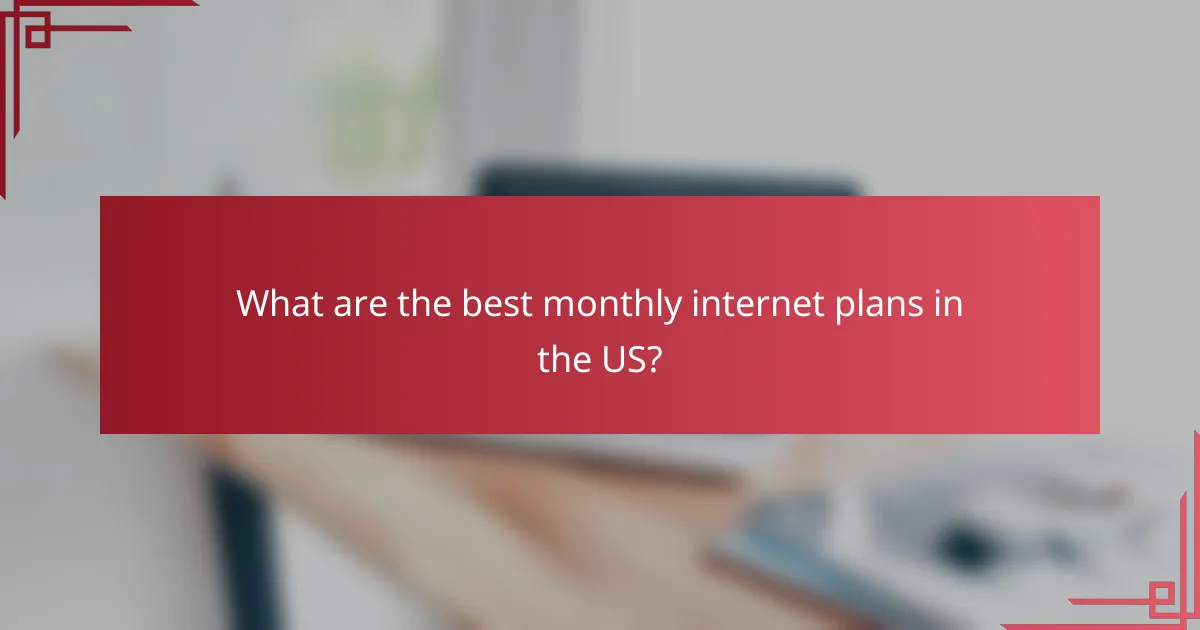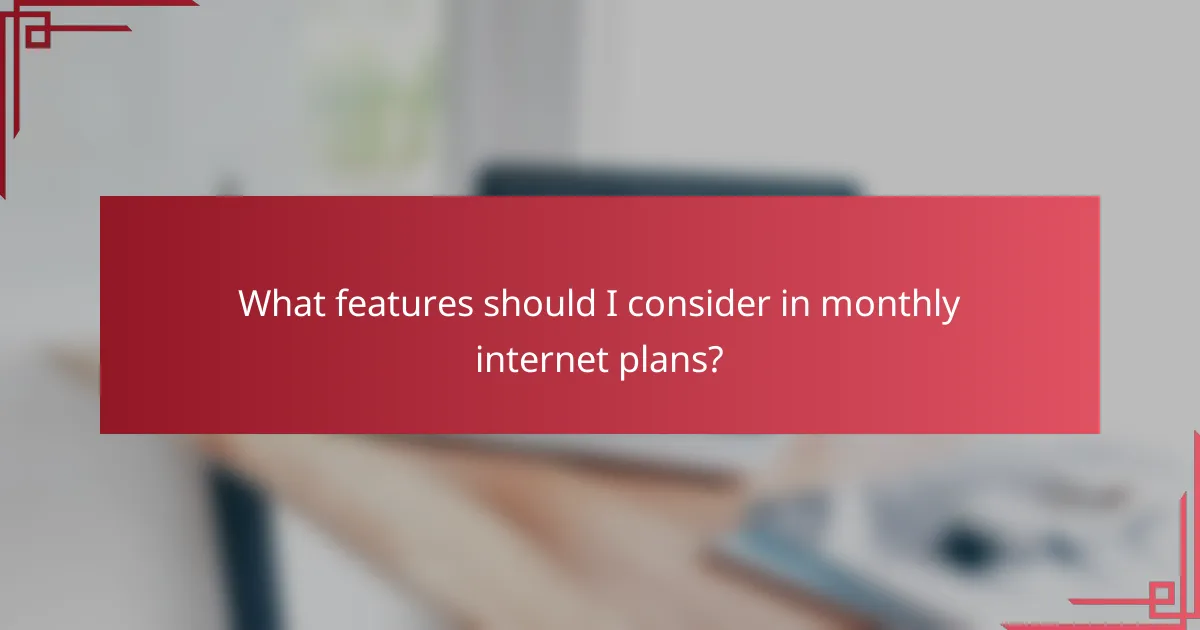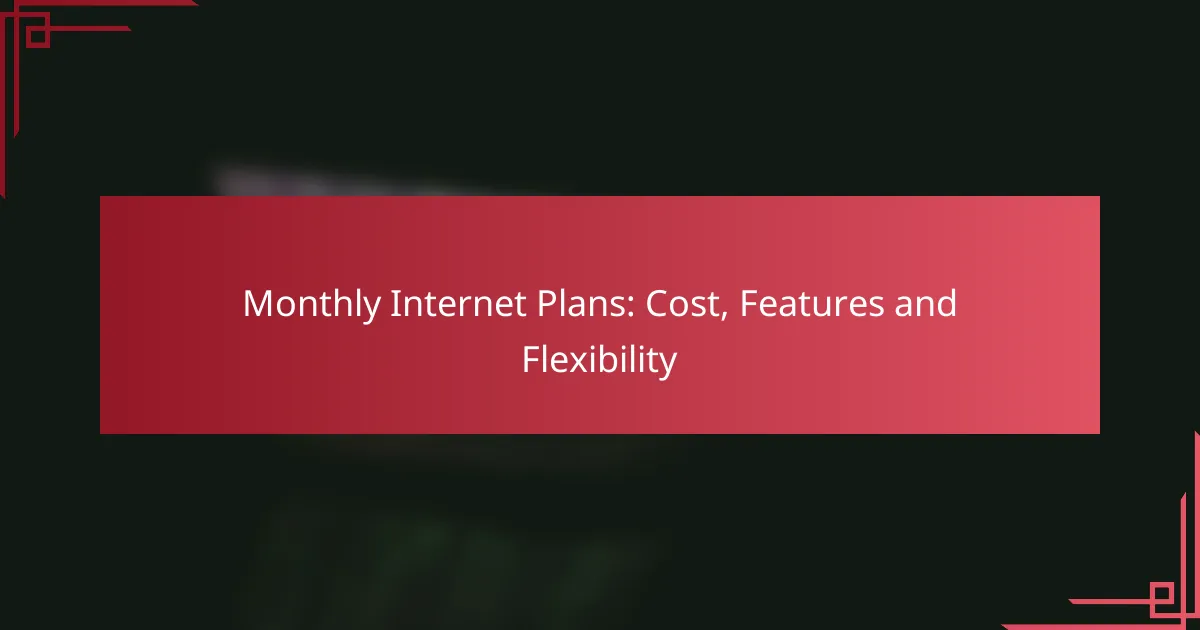Choosing the right monthly internet plan is essential for ensuring you have the connectivity that fits your lifestyle. With a range of options available from major providers like Verizon Fios, AT&T Fiber, and Comcast Xfinity, it’s important to consider factors such as speed, cost, and flexibility. Plans typically range from $30 to $100, offering various features to cater to different needs and preferences.

What are the best monthly internet plans in the US?
The best monthly internet plans in the US offer a balance of speed, cost, and flexibility to meet varying needs. Key providers include Verizon Fios, AT&T Fiber, Comcast Xfinity, Google Fiber, and CenturyLink, each with unique features and pricing structures.
Verizon Fios plans
Verizon Fios provides fiber-optic internet with speeds ranging from around 300 Mbps to 940 Mbps. Plans typically start at about $70 per month, offering reliable connectivity suitable for streaming and gaming.
Consider bundling options with TV and phone services for potential savings. Keep an eye on promotional rates that may apply for the first year, as prices can increase after the initial period.
AT&T Fiber plans
AT&T Fiber offers plans with speeds from 300 Mbps to 5 Gbps, catering to various household needs. Monthly costs generally start at around $55, making it a competitive option for high-speed internet.
AT&T often includes no data caps, which is beneficial for heavy users. Check for availability in your area, as fiber service may not be universally accessible.
Comcast Xfinity plans
Comcast Xfinity provides a range of plans with speeds from 50 Mbps to 1,200 Mbps. Prices typically start around $30 per month for lower-tier plans, but can increase significantly for higher speeds.
Xfinity offers flexible contract options, including no annual contracts for some plans. Be aware of data caps on certain plans, which can affect heavy internet users.
Google Fiber plans
Google Fiber is known for its straightforward pricing and high speeds, offering plans around 1 Gbps for approximately $70 per month. Some areas may also have a 2 Gbps option for a higher fee.
Google Fiber typically has no data caps, making it an excellent choice for families or users with high bandwidth needs. Availability is limited to select cities, so check if it’s offered in your location.
CenturyLink plans
CenturyLink offers DSL and fiber plans with speeds ranging from 15 Mbps to 940 Mbps. Monthly prices start at about $49 for lower-speed DSL options, with fiber plans priced higher.
CenturyLink’s pricing structure often includes a price-for-life guarantee on some plans, which can be appealing. However, service quality may vary significantly based on your location, so research local reviews before committing.

How much do monthly internet plans cost in the US?
Monthly internet plans in the US typically range from around $30 to $100, depending on the speed and features offered. Basic plans provide essential connectivity, while premium options include higher speeds and additional services.
Average cost of basic plans
The average cost of basic internet plans in the US is generally between $30 and $50 per month. These plans usually offer speeds around 25 to 100 Mbps, which are suitable for light browsing and streaming on a few devices.
Providers like Comcast and AT&T often have introductory offers that can reduce the initial cost, but these may increase after the promotional period ends. It’s advisable to check the terms carefully to avoid unexpected price hikes.
Average cost of premium plans
Premium internet plans typically range from $70 to $100 per month, offering speeds of 200 Mbps and above. These plans are designed for heavy users who stream in high definition, play online games, or have multiple devices connected simultaneously.
Many premium plans also come with additional features such as enhanced security, Wi-Fi mesh systems, or bundled services like cable TV. Consider your household’s internet usage to determine if the higher cost is justified.
Hidden fees and taxes
When evaluating monthly internet plans, be aware of potential hidden fees and taxes that can add to your overall cost. Common additional charges include installation fees, equipment rental fees, and regulatory fees, which can range from a few dollars to over $10 each month.
Always read the fine print and ask your provider for a breakdown of all costs involved. This will help you avoid surprises on your bill and ensure you understand the total cost of your internet service.

What features should I consider in monthly internet plans?
When evaluating monthly internet plans, focus on key features such as download and upload speeds, data caps, and contract terms. These elements greatly influence your internet experience and overall satisfaction with the service.
Download and upload speeds
Download and upload speeds are crucial for determining how quickly you can access content and share data online. Typical download speeds for residential plans range from 25 Mbps to 1 Gbps, while upload speeds can vary from 1 Mbps to 100 Mbps or more, depending on the plan.
Consider your usage habits: if you stream videos, play online games, or work from home, opt for higher speeds. For casual browsing and social media, lower speeds may suffice. Always check if the speeds are advertised as “up to,” which means actual performance may vary.
Data caps and limits
Data caps refer to the maximum amount of data you can use in a month without incurring extra charges. Many plans now offer unlimited data, but some still impose caps ranging from 100 GB to 1 TB. Exceeding these limits can lead to throttled speeds or additional fees.
Evaluate your data needs based on your online activities. Streaming high-definition content, for instance, consumes significantly more data than browsing. If you have multiple users or devices, consider plans that offer unlimited data to avoid unexpected costs.
Contract terms and flexibility
Contract terms dictate how long you commit to a service, often ranging from one to two years. Some providers offer month-to-month plans, which provide greater flexibility but may come at a higher monthly cost. Review cancellation policies and any early termination fees before signing.
Flexibility is essential if your internet needs may change. If you anticipate moving or changing your usage habits, look for plans that allow easy upgrades or downgrades without penalties. Always read the fine print to understand your options and obligations fully.

How do I choose the right internet plan for my needs?
Choosing the right internet plan involves understanding your specific usage requirements, comparing the features of different plans, and evaluating customer service ratings. By assessing these factors, you can find a plan that meets your needs without overspending.
Assessing usage requirements
Start by determining how you use the internet. Consider factors such as the number of devices connected, the types of activities you engage in (like streaming, gaming, or remote work), and the average data consumption per month. For instance, a household that streams HD videos frequently may require a plan with higher bandwidth compared to one that primarily browses the web.
As a general guideline, plans offering speeds of 25-50 Mbps are often sufficient for casual users, while heavy users may need 100 Mbps or more. Keep in mind that higher speeds usually come with increased costs, so balance your needs against your budget.
Comparing plan features
When comparing internet plans, look beyond just the price. Key features to consider include speed, data caps, contract terms, and additional perks like free installation or equipment rental. Some providers may offer unlimited data, which is beneficial for users who stream or download large files regularly.
It’s also wise to check if the plan includes any promotional rates that might expire after a certain period. Ensure you understand the long-term costs to avoid surprises when the promotional period ends.
Evaluating customer service ratings
Customer service quality can significantly impact your experience with an internet provider. Research customer reviews and ratings to gauge the reliability of their support. Look for feedback on response times, issue resolution, and overall satisfaction.
Consider checking resources like the Better Business Bureau or consumer review sites to get a sense of how well a provider handles complaints. A provider with strong customer service may be worth a slightly higher price if it leads to a smoother experience overall.

What are the advantages of flexible internet plans?
Flexible internet plans offer several benefits, including adaptability to changing needs and reduced commitment. They allow users to adjust their service without being locked into long-term contracts, making them ideal for varying usage patterns.
No long-term contracts
One of the primary advantages of flexible internet plans is the absence of long-term contracts. This means users can avoid penalties for early termination and switch providers or plans as their needs change. Many providers offer month-to-month options, allowing for greater freedom and control over expenses.
Without long-term commitments, customers can easily explore different service providers to find the best fit for their requirements. This flexibility can lead to better pricing and service quality, as users are not tied down to a single provider.
Ability to upgrade or downgrade
Flexible internet plans typically allow users to upgrade or downgrade their service based on current needs. For example, during periods of increased internet usage, such as working from home or streaming, users can opt for higher bandwidth. Conversely, they can reduce their plan during slower months to save on costs.
This adaptability is particularly beneficial for households with varying internet demands. Users can easily adjust their plans without incurring significant fees, ensuring they only pay for what they need at any given time.
Trial periods and satisfaction guarantees
Many flexible internet plans come with trial periods or satisfaction guarantees, allowing users to test the service before fully committing. This feature helps customers assess the quality and reliability of the internet connection, ensuring it meets their expectations.
Providers may offer trial periods ranging from a few weeks to a month, during which users can cancel without penalties if they are unsatisfied. This approach reduces the risk of making a poor choice and encourages providers to deliver high-quality service to retain customers.

What are the common pitfalls when selecting an internet plan?
Common pitfalls when selecting an internet plan include failing to read the fine print, misjudging data limits, and overlooking hidden fees. These mistakes can lead to unexpected costs and service limitations that may not meet your needs.
Overlooking fine print
Overlooking the fine print can result in significant misunderstandings about your internet plan. Many providers include essential details regarding pricing, contract length, and service limitations that may not be immediately obvious.
For example, promotional rates often expire after a few months, leading to much higher monthly costs afterward. Additionally, some plans may have data caps or throttling policies that can affect your internet speed after reaching a certain usage threshold.
To avoid these issues, always read the terms and conditions carefully. Look for details on pricing changes, data limits, and any potential fees for exceeding those limits. This diligence can save you from unexpected charges and ensure you choose a plan that truly fits your needs.



